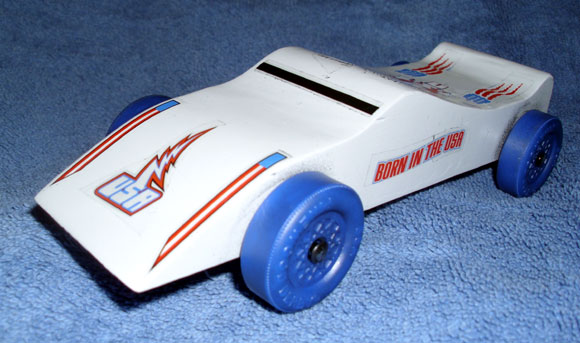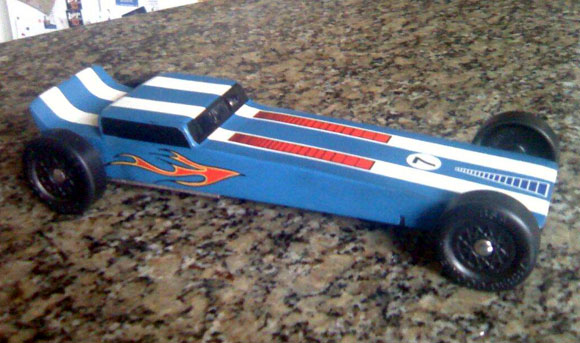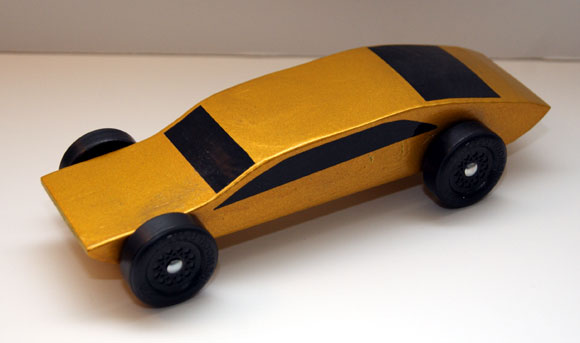– Feature Article – Do’s and Don’ts for Race Leaders
– Pinewood Derby Car Showcase
– Q&A
Do’s and Don’ts for Race Leaders
By Randy Davis
On March 13, 2011 I received an e-mail from an upset customer. They had used some of our BSA wheels in their pack race, and did well enough to go to their district race. But at the district race they ran into a problem. The race inspector disqualified a large percentage of the cars (over sixty cars were disqualified) because the wheels were too narrow. The customer’s car was one of the 60. I asked the customer to send me a copy of the rules for the race. Amazingly enough, a minimum wheel width was not specified in the rules. So, I told the customer that there was no reason for the disqualification, and that they really should notify the district officials of the problem.
Then on Monday, I received three phone calls and e-mails from different customers regarding the same problem. All of them realized that they had been treated unfairly. One of them described how the official would look at the wheel, and then if it looked home processed it was not measured (even though some sets of home processed wheels where clearly very narrow). But if the wheels were nicely machined, then the inspector measured the wheels, and used the non-documented specification to allow or disallow the wheels. Amazing.
I don’t know the motivation of the inspector at this race. Two of the customers thought he had a vendetta against DerbyWorx (one supplier of machined wheels), and another thought he was trying to eliminate competition for a friend’s son. Maybe he just got out of the wrong side of the bed that morning. But whatever the reason, at least sixty kids and their parents went home disappointed because they could not race.
If this was a one in a million occurrence, then there would be no need for this article, but unfortunately this type of aberrant inspection occurs all too often. I hear of many instances where undocumented standards are used at the inspection, rules are changed within a few days of the event(1), or rules are not made available to race participants.(2)
So, in an effort to help prevent this type of occurrence, I would like to share the following principles for running a fair race.
Provide Rules To All Participants
Every race participant must be given a copy of your local rules. These rules should be provided as a hard copy when the kit is distributed, or posted on your group’s web site in a very conspicuous location.
If you are using the rules from a parent organization (such as a BSA district or council), replicate the rules on your group’s web site in a conspicuous location, or provide a hard copy. Do not tell parents to, “Just look on the district’s web site”. Finding rules on some of these sites can be challenging – don’t make your members struggle to find the rules for your race.
Clear Rules
Make sure that the rules you are using are clear and up to date. If you want to ban or allow a particular technique, then specifically state that the technique is, or is not allowed. For example, if you want the axle slots on the kits to be used, then state, “The axles must be mounted in the axle slots on the block.” Don’t say, “The block from the kit must be used”, because this would allow the builder to drill axle holes on the other side of the block.
Here is a minimum list of techniques that should be specifically stated as being allowed or disallowed:
- 3 or 4 wheels on the ground
- Axle slots or holes
- Existing or modified wheelbase
- Allowed/banned lubricants
- Grooved/non-grooved axles
- Weight-reduced/full weight wheels
- Narrowing of wheels
- Tread modification.
Certainly there are other techniques to consider, but documenting the techniques in the above list will greatly clarify what can and cannot be implemented by the car builder. But be careful, if a technique is banned, then the race inspectors must check for the use of that technique. So make sure there is a method for inspecting whether or not the technique is used.(3)
Don’t Change The Rules After They Are Handed Out
Once the rules are distributed, they cannot be changed. If rules are changed after the kits are distributed then those people that don’t procrastinate will be penalized. Just plan to make the rule change for next year’s race.
Don’t Inspect If Not Documented
Inspecting for non-documented items is one of the most common complaints I hear from parents. I call it “legislating from the bench”, because it is essentially a judge (who is supposed to rule on the law) making a law (which is not in his/her mandate).
If a particular technique or specification is not documented in the rules, the inspection committee must not inspect for that technique. For example, if the rules do not state that all four wheels must be on the ground, then three wheels on the ground must be allowed, and the inspection committee must not check for this technique. If there is no specification in the rules for wheel measurements, then don’t measure the wheels. I think you get the idea.
Don’t Document And Not Inspect
Every technique banned in the rules must lead to an inspection step. If an inspection is not performed for each banned technique then the “honest” car builders are penalized.
The method of inspection must be easy to perform, and very repeatable. The best way to accomplish this is with purpose-built gauges. The most common gauge is the “Go/No-go Box”. This gauge quickly determines if the car meets all of the dimensional specifications. Another gauge is the Wheel Go/No-go Gauge. If the rules state a minimal wheel diameter or wheel width, then a Wheel Go/No-go Gauge is used to determine if the wheel is legal. Do not use a digital caliper for this check. Digital calipers are prone to error, as each wheel must be measured in the exact same location, with the proper angle, and with the proper pressure. If any of these are inconsistent, the measurements will be prone to error. This is especially true of wheel diameter; the wheels are flexible and too much pressure on the caliper will cause the diameter to read smaller than it actually is.
Some techniques cannot be readily tested at the weigh-in. These include: grooved axles, the use of bearings or bushings, wheel weight reduction, et al. If these techniques are banned by your rules, then a post race tear-down will be required. This tear-down consists of removing one or more of the wheel/axle sets from the trophy-winning cars. The wheels can then be easily weighed, measured and inspected, and the axles can be inspected. If a car is found to violate the rules, then the car is disqualified, and the cars below move up a step in finish order.
Conclusion
I encourage all race leaders to review the rules for your race for completeness, accuracy, and availability. Then review your inspection process to make sure you are inspecting to the rules. These simple steps can help make your race more organized and enjoyable for all.
Notes
(1)Several times people have told me that they built an extended wheelbase car, which was legal at the previous year’s event. But two days before the race, new rules were issued which required standard wheelbase cars. So the racers had less than two days to build a new car.
(2)”Just use the rules in box” is a common phrase that participants are told by the race leader. Of course, the rules in the box (whether it is a BSA kit, Awana kit, etc.) are quite open with little restriction. But when the car is inspected, the child/parent is told by the inspector:
“You can’t do that. That’s illegal.”
“Where is that documented?”
“Right here”, says the inspector.
“But I didn’t get a copy of that; I was told to use the rules in the box!”
“Sorry, I can’t help that”, says the inspector. “Next car!”
(3)A common rule is “Only dry lubes can be used”. But how do you inspect for this? Even if you do a post race tear-down, determining that a liquid lube was used is very problematic. Therefore, I am a proponent of not regulating lubricants.
Pinewood Derby Car Showcase
American Glory – Cannon Knapp
This was Cannon’s last Pinewood Derby. He designed and built the car all on his own. It placed second in the pack race!
Low Rider – Michael & Jakob DeAno
Our car took second place overall and was voted best looking car. We ordered all the material from you folks and were very satisfied. We are already thinking of the car for the next race.
Gold Coupe – Brenden Paul
Brenden’s car finished in the top five, just a few thousandths of a second out of trophy position. The tungsten weights and window decal material was purchased from Maximum Velocity.
Q&A
I’m new to running derbies and I was wondering if I could get your advice. In our race there were four divisions. The winners of three of those divisions were flat cars (like 1/2 inch thick) and the other division’s winner was a slim wedge. All had aggressive COGs and were built by people who knew a thing or two about car construction.
After the race, a parent complained that they felt there was no skill in building a flat car and they suggested that we have two race categories next year – one for car-looking cars, the other for the more aggressive flats and wedges.
What do you think about that?
Well, building a fast car certainly requires skills, but not necessarily the same skills required to build a good-looking car.
Most races have design awards as well as speed awards. So the people that take the time to build a nice looking car (but not necessarily fast) are still in the running for an award.
In our race, we let the race participants vote for their favorite car. However, with this method, a fast flat car with a nice paint job will sometimes win a design award and a speed award.
I have heard of races where all entries must look like a car (or truck). Other races require that all entries look like a household object (food, appliance, tool, etc). There are some races that have a “Door-Slammer” category, where the cars are plastic model bodies mounted on a pinewood derby frame. This can be quite challenging as plastic models are not quite the same form-factor as the pinewood derby block. So, you can certainly try something different.
Regarding the suggestion of a category for “car-looking cars”, recognize that there will be cars that will not easily be placed into one of the two categories (for example, a wedge with a plastic engine). This will likely lead to disagreements and hurt feelings.
My son and I polish the inside bore of our wheels using a length of pipe cleaner chucked in a drill, along with the plastic wheel polish you sell. I was just wondering, doesn’t a highly polished bore prevent the graphite from sticking to the plastic?
I don’t believe that the smoothness of the bore has any affect on building up a graphite coating on the bore. However, if you get enough of a graphite coating built up on the wheel bore, the smoothness of the plastic is not really a big factor (because the axle is only contacting the graphite). But if the graphite coating is not complete, or starts to break down, then a smooth bore is very important. Smooth bores are much more important when using liquid lubes.
Want Answers?
Do you have a pinewood derby-related question? If so, e-mail us your question.We answer all questions by e-mail, but not every question will appear in the Q&A section of the newsletter.
Back Issues
Are you a new subscriber, or have you missed some of the previous newsletters? Don’t miss out; all of the issues for Volume 5 through Volume 17 are posted on our web site.
Newsletter Contributions
We welcome your contributions. If you would like to contribute an article, a web site review, a speed tip, or a pinewood derby memory, please e-mail us.
Subscription Information
The Pinewood Derby Times is a free e-newsletter focused on pinewood derby racing. It is published biweekly from October through March.
If you haven’t already done so, please forward this issue to your pinewood derby friends. But please don’t subscribe your friends. Let them decide for themselves. Thanks.
If this newsletter was forwarded to you, why not subscribe to receive this newsletter. There is no cost, and your e-mail address is safe, as we never sell or share our distribution list.
To subscribe, send a blank e-mail to
[email protected]
You will receive a confirmation e-mail. Reply to the confirmation e-mail and you will start receiving the Pinewood Derby Times with the next issue.
Randy Davis, Editor, Pinewood Derby Times
E-Mail: [email protected]
(C)2018, Maximum Velocity, Inc. All rights reserved. Please do not reprint or place this newsletter on your web site without explicit permission. However, if you like this newsletter we grant permission, and encourage you to e-mail it to a friend.
Maximum Velocity disclaims any personal loss or liability caused by utilization of any information presented in this newsletter.
The Pinewood Derby Times is not specific to, and is not affiliated with the Boy Scouts of America, YMCA, Awana, or any other organization.
(R)Maximum Velocity is a registered trademark of Maximum Velocity, Inc.
(R)Pinewood Derby is a registered trademarks of the Boys Scouts of America.
(R)Awana is a registered trademark of Awana Clubs International.
All other names are trademarks of their respective owners.



